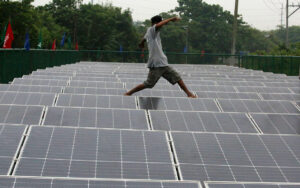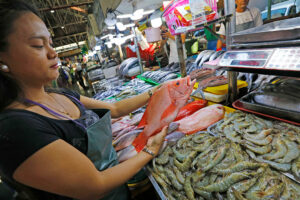More Filipinos turn to solar panels as energy costs bite

By Ashley Erika O. Jose, Reporter
JENNELYN VALENCIA-BURGOS, 33, is among many Filipinos who have installed solar panels on her roof to ease costs in a country with the most expensive power rates in Southeast Asia.
Ms. Burgos, who spent P65,000 ($1,145) on her solar panels, said her monthly electricity bill used to cost as much as P1,000 a month. Now, there are months when she doesn’t have to pay for power.
“It’s worth it, especially if you have several panels,” she said in a Facebook Messenger chat. “Yes, it’s expensive, but it will really save you money.”
The Philippines relies heavily on imported coal, most of it from Indonesia and Australia, exposing its electricity system to political unrest, price volatility and the risk of unfavorable foreign exchange rates.
There’s a push for renewable energy and solar energy is expected to drive the Philippines’ renewable energy growth in the next decade, according to a report from Fitch Solutions Country Risk and Industry Research.
The country aims to increase the share of renewable energy in its power mix to 35% by 2030 and 50% by 2040 from 22% now.
Household use of solar panels is being pushed to ease the effects of rising electricity prices. Solar rooftops are expected to help households especially during the summer months when power supply is tight.
Early this year, the Luzon power grid was placed under red and yellow alerts, with more than 300,000 customers in Metro Manila and nearby provinces experiencing brownouts after transmission lines tripped, forcing two power plants to shut down.
Another measure being pushed by the Department of Energy (DoE) is the net metering program, which allows household consumers with renewable energy facilities such as solar power to use electricity when needed while contributing their output to the grid.
Net metering, which allowed consumers to earn credit for their power export, was the first policy mechanism of the Philippine Renewable Energy Act of 2008 that was first implemented. The program is open to users with a capacity of as much as 100 kilowatts (kW).
There were 6,665 net metering customers at the end of last year with an installed capacity of 40,075 kilowatts peak (kWp), according to Ferdinand O. Geluz, Manila Electric Co. first vice-president and chief commercial officer.
The Energy Regulatory Commission (ERC) has said net metering protects consumers from rising electricity prices.
To qualify, a consumer must apply with a distribution utility for evaluation, inspection, completion and commissioning, but the application process varies from local government to local government.
To install a solar photovoltaic (PV) system with net metering, a customer needs a solar PV panel that absorbs light, and a DC/AC inverter that converts the panel’s direct current output to alternating current, which can then be fed into a commercial electrical grid or used off grid.
COMPLIANCE HURDLESSenator Sherwin T. Gatchalian, vice-chairman of the Senate Energy Committee, has proposed to remove the 100-kW cap for net metering to encourage more Filipinos to invest in renewable energy.
The Energy Regulatory Commission last year approved the use of renewable energy of as much as 1 megawatt (MW).
“Last year, we issued the regulatory framework for distributed energy resources or DERs that already allows the installation of up to 1-megawatt (MW) RE installations for a customer’s own use,” ERC Chairperson and Chief Executive Officer Monalisa C. Dimalanta said in a Viber message.
“This 1-MW cap will be reviewed after one to two years to see if there is demand to increase the cap,” she said.
This would allow the regulator to unlock the ability of large consumers to choose and provide themselves with renewable energy, Ms. Dimalanta said, “while managing the impact on remaining captive customers of distribution utilities.”
She added that current procedures are already enough and streamlined and that the challenge in solar rooftop utilization now lies within local government units.
Ms. Dimalanta noted that on the regulatory side for residential consumers, the procedure is already clear and streamlined.
“It is now a matter of implementation to make sure it is seamless from the national agency to the distribution utility to the local government unit,” she said. “The remaining challenges are information dissemination and access to financing.”
Solar PV installations are not yet widespread in the Philippines mainly due to lack of awareness among homeowners, according to the Institute for Climate and Sustainable Cities (ICSC).
“Many consumers are not yet aware of the potential cost savings attributed to solar energy on their rooftop,” Jephraim C. Manansala, ICSC chief data scientist said in a Viber message.
Some Filipinos hesitate to have a solar PV system because they don’t know how to maintain and operate it, he said. “Others may also be unsure about which type of solar PV system to utilize — whether a grid-tied or a hybrid system.
Many homeowners also find the permitting process difficult. “Some local government units have a streamlined process for solar PV installations, while others are not yet prepared for this,” Mr. Manansala said.
Some solar panel installations fail to comply with the requirements of the distribution utility and are not monitored by the government, he added.
“Regulatory oversight including monitoring by distribution utilities and the government, or installation compliance requirements for renewable energy certificate meters may be challenging for some consumers, leaving them disincentivized to register and install solar PV systems,” Mr. Manansala said.
“Addressing these challenges will require collaboration between diverse stakeholders including government agencies, distribution utilities and consumers,” he added.




